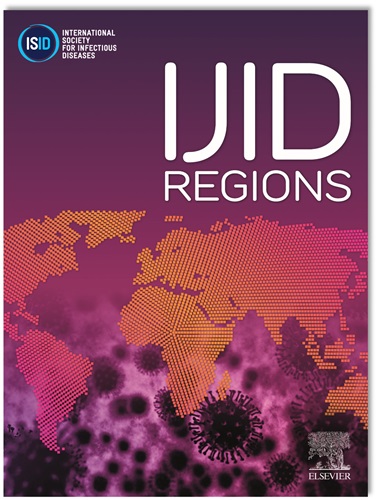2012-2024年巴西登革热危重患者的临床特征、并发症和结局:一项全国多中心队列研究
IF 4.3
2区 医学
Q1 INFECTIOUS DISEASES
引用次数: 0
摘要
背景:登革热疫情是一个主要的公共卫生问题,2024年巴西报告的病例占全球病例的71%。目的:本研究旨在描述2012-2024年入住巴西重症监护病房(ICU)的重症登革热患者的概况,评估随时间变化的趋势,描述ICU期间新发并发症,并确定入院时ICU住院期间发生并发症的危险因素。方法:我们对56家医院253个icu的登革热患者进行了前瞻性研究。我们使用描述性统计来描述登革热ICU人群,使用逻辑回归来确定ICU住院期间并发症的危险因素,并使用机器学习框架来预测演变为并发症的风险。可视化使用ISARIC VERTEX生成。结果:在11047例住院患者中,1117例(10.1%)发生并发症,包括无创(437例)和有创通气(166例)、血管加压(364例)、输血(353例)和肾脏替代治疗(103例)。年龄≥80岁(OR: 3.10, 95% CI: 2.02-4.92)、慢性肾脏疾病(OR: 2.94, 2.22-3.89)、肝硬化(OR: 3.65, 1.82-7.04)、低血小板(7000个细胞/mm³;OR: 2.47, 2.02-3.03)是并发症的重要危险因素。提出了一种预测并发症的机器学习工具,具有准确的识别和校准功能。结论:我们描述了一大批icu收治的登革热患者,并确定了严重登革热并发症的关键危险因素,如高龄、合并症的存在、白细胞水平较高和血小板水平较低。提出的预测工具可用于早期识别和有针对性的干预措施,以改善登革热流行地区的结果。本文章由计算机程序翻译,如有差异,请以英文原文为准。
Clinical characteristics, complications and outcomes of critically ill patients with Dengue in Brazil, 2012-2024: A nationwide, multicenter cohort study
Background
Dengue outbreaks are a major public health issue, with Brazil reporting 71% of global cases in 2024.
Purpose
This study aims to describe the profile of severe dengue patients admitted to Brazilian intensive care units (ICUs) (2012-2024), assess trends over time, describe new onset complications while in ICU, and determine the risk factors at admission to develop complications during ICU stay.
Methods
We performed a prospective study of dengue patients from 253 ICUs across 56 hospitals. We used descriptive statistics to describe the dengue ICU population, logistic regression to identify risk factors for complications during the ICU stay, and a machine learning framework to predict the risk of evolving to complications. Visualizations were generated using ISARIC VERTEX.
Results
Of 11,047 admissions, 1117 admissions (10.1%) evolved to complications, including non-invasive (437 admissions) and invasive ventilation (166), vasopressor (364), blood transfusion (353), and renal replacement therapy (103). Age ≥80 (odds ratio [OR]: 3.10, 95% confidence interval: 2.02-4.92), chronic kidney disease (OR: 2.94, 2.22-3.89), liver cirrhosis (OR: 3.65, 1.82-7.04), low platelets (<50,000 cells/mm³; OR: 2.25, 1.89-2.68), and high leukocytes (>7000 cells/mm³; OR: 2.47, 2.02-3.03) were significant risk factors for complications. A machine learning tool for predicting complications was proposed, showing accurate discrimination and calibration.
Conclusion
We described a large cohort of dengue patients admitted to ICUs and identified key risk factors for severe dengue complications, such as advanced age, presence of comorbidities, higher level of leukocytes, and lower level of platelets. The proposed prediction tool can be used for early identification and targeted interventions to improve outcomes in dengue-endemic regions.
求助全文
通过发布文献求助,成功后即可免费获取论文全文。
去求助
来源期刊
CiteScore
18.90
自引率
2.40%
发文量
1020
审稿时长
30 days
期刊介绍:
International Journal of Infectious Diseases (IJID)
Publisher: International Society for Infectious Diseases
Publication Frequency: Monthly
Type: Peer-reviewed, Open Access
Scope:
Publishes original clinical and laboratory-based research.
Reports clinical trials, reviews, and some case reports.
Focuses on epidemiology, clinical diagnosis, treatment, and control of infectious diseases.
Emphasizes diseases common in under-resourced countries.

 求助内容:
求助内容: 应助结果提醒方式:
应助结果提醒方式:


